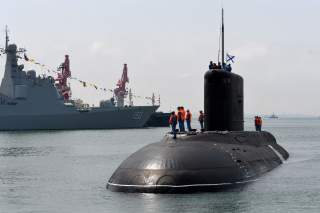Did A Russian Built Submarine 'Sink' A U.S. Navy Sub Back in 2015?
How could that be?
Key Point: Because U.S. submarines have to project power a lot farther from home, much more is expected of their mission.
Is it possible that one of New Delhi’s Russian-built Kilo-class diesel-electric attack submarines managed to “sink” a nuclear-powered U.S. Navy Los Angeles-class attack submarine during exercises in October 2015?
The Indian submarine INS Sindhudhvaj (S56) allegedly “killed” USS City of Corpus Christi (SSN 705) during an exercise called Malabar that is held annually between India, Japan and the United States.
According to the Indians, the submarines were assigned to track each other down in the Bay of Bengal. “The way it happens is that the Sindhudhvaj recorded the Hydrophonic Effect (HE) - simply put, underwater noise - of the nuclear powered submarine and managed to positively identify it before locking on to it. Being an exercise what did not happen was the firing,” an Indian naval officer told India Today. The Indian vessel then “sank” USS City of Corpus Christi using 533mm torpedoes.
If the Indian description of the events is correct, it would be a bright spot in an otherwise dismal record for New Delhi’s undersea force.
In recent years, the woefully neglected Indian submarine fleet has suffered numerous calamities. Submarines have run aground, caught fire and even sunk due to a combination of underinvestment, negligence and corruption. Perhaps the worst incident was when INS Sindhurakshak sank when at harbor in Mumbai after a series of explosions in the forward torpedo bay, killing eighteen sailors.
Nonetheless, it’s not a huge surprise that a Russian-built Kilo would be able to defeat a Los Angeles-class attack boat. The Los Angeles-class is a dated design that is slowly being replaced by the newer and exponentially quieter Virginia-class submarine. However, it must be noted that we do not know the rules of engagement or parameters that the sides had agreed to. Furthermore, it must be noted there is the possibility of exaggeration.
But the basic facts are that the Kilo is an extremely quiet and very capable submarine owing to its diesel-electric propulsion system. Running on electrical power while submerged, diesel-electric boats have been described as “a hole in the water” or a "black hole" and are a vexing problem for the U.S. Navy. Developing ways to counter such vessels is a high-priority for Washington as many potential adversaries like China and Iran operate such submarines.
While diesel-electric boats are generally quieter than nuclear submarines, the U.S. Navy prefers atomic powered vessels because of their range, speed and endurance. The U.S. Navy’s global mission essentially mandates a vessel that can operate independently far from home waters for extended periods. Navies with a more localized mission can afford to operate short-range diesel-electric boats.
While the Indian report may or may not be correct, this incident highlights the need to completely replace the Los Angeles-class with Virginia-class boats as soon as possible.
The Virginia-class is orders of magnitude quieter and offers far better sensors and carries more weapons. The newer vessels are far more effective against threats like the Kilo than their Los Angeles-class predecessors. Buying as many Virginias as possible becomes especially important as more and more potential adversaries procure advanced diesel-electric boats like the Kilo or the even more capable Russian-built Amur.
This piece was originally featured in 2015 and is being republished due to reader's interest.
Media: Reuters

